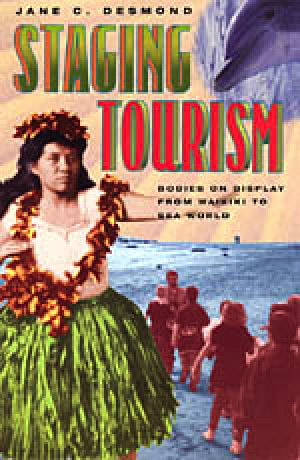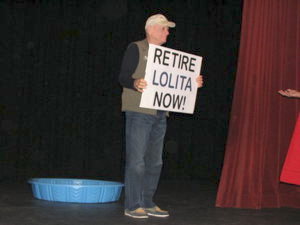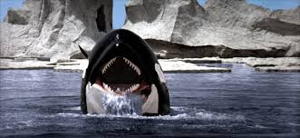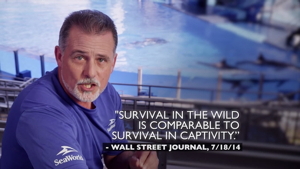Animal outlaws:
capitalism, containment, and documentary activism
“Watching the video, knowing Orkid, your stomach drops because you know what’s probably going to happen,” explains John Hargrove, former trainer at SeaWorld, San Antonio, and subsequent best-selling author.[1] [open endnotes in new window] Shortly after Hargrove begins narrating the terrifying event unfolding onscreen, the idiom for embodied anticipation is literalized as the camera abruptly drops to the ground. The loss of our visibility heightens the chaos of witnessing, both for the videographer and now for us, viewers of Blackfish (Gabriela Cowperthwaite, 2013). What we are watching is a video inadvertently caught by a park patron of a near-death encounter between a SeaWorld trainer and two orcas (Orkid and Splash). The importance of this accidental video is two-fold: it foregrounds the deception practiced by marine park corporations and their ability to manipulate images to confirm their version of events. Indeed, the juxtaposition between worker testimonies and corporate rhetoric throughout the film is enlightening. Second, the video is an example of our position in relation to the documentary’s interviewees—at this point in the film, we are aligned with the former employees and researchers, we no longer trust the sanitized spin proffered by SeaWorld. Though Blackfish is now known mostly for its success in shifting public opinion against animals in captivity for amusement and profit, its union of viewer with worker is equally disruptive. The documentary encourages a radical empathy that shifts blame away from low-wage workers and commoditized animals and back onto the corporations that exploit them.
On February 24th, 2010, Dawn Brancheau, a trainer at the SeaWorld park in Orlando, Florida was killed by Tilikum, a male orca with a documented history of aggression. Like many viewers around the nation, documentarist Gabriela Cowperthwaite found the news story both horrifying and incomprehensible.[2] The incident prompted her to investigate the tragedy, which necessitated looking into the systemic problem of animals as entertainment and profitable commodities. The documentary focuses on the potentially dangerous psychical repercussions of pod separation and captivity, and the consequences of covering up an orca’s past transgressions. As we learn about the first marine parks in North America through to the latest incident at Sea World, Orlando, it becomes clear who/what are dispensable when maintaining a corporate veneer of safety and education.
Blackfish engages with activist discourse begun by other animal rights documentaries—particularly those concerned with captive cetaceans. Blackfish distinguishes itself from the others by its spectacular monetary returns,[3] its ubiquity on television and in movie theaters, and, most importantly for the sake of this essay, for incorporating a nuanced pro-worker perspective. Documentaries like Lolita: A Slave to Entertainment (Tim Gorski, 2003), The Whale (aka Saving Luna, Suzanne Chisholm and Michael Parfit, 2011), and The Cove (Louie Psihoyos, 2009),[4] resemble each other in their use of stock footage of cetaceans in the wild, interviews with those affected by the malpractice of marine parks, and several shared witnesses that testify to the dangers of captivity and the parks’ “willing partner discourse”[5] (i.e. success in presenting the human and animal as working together). A lively activist spirit is effective and contagious in each of these films, which forces us to reckon with previously held beliefs about what constitutes animal abuse. Thus the patron video is an illuminating insight into the very thesis of Blackfish’s argument: unofficial modes of information, transmitted from those outside the corporate sphere, are to be relied upon when attempting to make sense of traumatic, almost always preventable,[6] catastrophes. Indeed the work of activist texts speaks to the continued necessity of documentary films and activism as an art practice.
Just like us
Among the handful of memoirs and exposés written on SeaWorld as a dangerous space for workers, animals, and patrons, are two critical book-length studies on the marine park: Susan Davis’ Spectacular Nature, which examines SeaWorld as a corporate entity, and Jane Desmond’s Staging Tourism. Desmond’s work is a particularly formative text for those interested in analyzing SeaWorld from a critical cultural studies perspective. Though her book is about various types of tourism practiced by westerners, her examples range from Americans vacationing in Hawaii, as well as less traditionally exotic experiences that she calls “nature tourism”—marine parks, aquaria, and other sites that give the illusion of natural habitats.[7] She includes in her analysis circus-like events and other activities that require paid admission to witness animals on display or performing. The opportunities to temporarily visit an “other” (species, cultures, nature) are united by our insistence on witnessing tradition and nature no matter the mediated mode.
 |
 |
| Jane Desmond’s Staging Tourism is a formative text for the study of animal entertainment. | Susan Davis’s Spectacular Nature explores the corporate structure of SeaWorld. |
For Desmond, human and animal bodies perform tourism, thus she is cognizant of the similarities between animals on display and their human analogs. Though SeaWorld disavows the labor of its employees—whale shows are presented as great fun, a collaborative encounter between two willing participants unites its human patrons and mammals on display through a family-friendly rhetoric. The animals are like us—they have family units, they are gendered,[8] in heteronormative relationships, and produce offspring. The visual and cultural signifiers of family entice patrons to anthropomorphize the mammals, to see ourselves in them, thus rendering the tourism of species less radical than it would appear. The family friendly rhetoric not only effaces the labor of the trainers, it also successfully shields patrons from what would normally be considered an ecstatic, sublime experience—being up close to orcas. Blackfish contradicts SeaWorld’s self-promotion and the false sense of security we may feel from commodifying animals through expert testimony and interviews with researchers (many of whom explicitly state their unwillingness to approach orcas in the wild and insist on observing boundaries). Like other forms of tourism, however, the whale shows, or the parks more broadly, become a seemingly safe place for us to project our ideologies onto an “other.”
According to Desmond, then, an implicit bargain is struck between patrons and the SeaWorld corporation: we disavow the corruption that undergirds the spectacle and simultaneously accept their claims that differences between animals and humans are minimal. SeaWorld both capitalizes on a specific demographic as well as encourages their cyclical return.[9] The consumers that typically patronize SeaWorld are straight, middle- to upper-class families.[10] Neutralizing the difference in speciesism, SeaWorld suggests that the relationships between their customers and the animals, as well as between their trainers and the animals, and even among the animals, resemble a nuclear unit, much like the consumers themselves. As Blackfish, Desmond, and those interviewed for the documentary attest, this vision of nuclear harmony disavows the practice of pod separation and what we know about their social structures in the wild. According to researchers, orcas are matriarchal, their calves mature and remain close to their pod for their entire lives, and they thrive on these relationships. Blackfish stresses the incongruity of corporate presentation and lived experience by the orcas through loss as a thematic concern—it is not just the performances or the uncomfortable tanks, but the loss of communication and ability to partake in familial relationships typical in the wild.
Tilikum, Luna, and Willy: animals as entertainment
“Teaching a killer whale to swim with a human being and do tricks in exchange for food was invented on the Seattle waterfront in 1965.”[11]
The history of animals as entertainment is rife with slaughter, confinement, monetary profit, and exploitation. In John Berger’s seminal essay, “Why Look at Animals?” he briefly sketches an extensive history of how we look at and relate to animals.[12] Drawing on a varied sample of artistic representations, the modern institutionalization with the onset of zoos, and their current status as commodity or entertainment, his article stresses the parallelism between the ubiquity of animal imagery and their subsequent disappearance from human life. Berger views our present-day engagement an unfortunate moment between humans and animals, who once played a great role in our lives either through myth, or later, husbandry.[13] For Berger, the animal behind the cage—or the orca in the tank—is “rendered absolutely marginal.”[14] When we look at animals, do we efface their observations of us?
As Berger stresses, part of our engagement with animals, especially in the last two hundred years, includes observation—we like to look at animals. Peppered throughout his analysis are examples of animals as represented through different media. Indeed, when we take a moment to reflect, some of our knowledge of orca behavior comes from popular forms of entertainment—specifically, cinema. Culturally, we do not think of killer whales (or any mammal from the dolphin family) as posing a danger to our well-being. Consider the popular fictional representation of an orca in Free Willy (Wincer, 1993), a formative text for our perception of large marine mammals. Free Willy exposes the dual role of cinema in the study of animals: movies in which they are featured, and movies as an activist method (both of which mirror the great cinematic binary: documentary and fictional modes of filmmaking).
Free Willy is a peculiar case study, so effective it eventually led to the actual freeing of its orca star.[15] On quite the opposite end of the spectrum is Orca (1977), a shameless imitation of Jaws (Spielberg, 1975). The snippet included in Blackfish serves as the single humorous moment, as Orca longs to scare us by replacing a man-eating shark with an orca. Following in the success of Flipper—the television show starring a dolphin—the attempted terror of Orca is all the sillier. While Free Willy caters to our ideas about orcas (and dolphins) as dog-like and not known to inspire fear in humans, we have not completely invented our notions about orcas. Historical records attest to the demeanor we attribute to them, too. A researcher interviewed in Blackfish states that there are no recorded incidents of an orca attacking a human in the wild. Carl Safina’s recent book on the emotional lives of whales, among other mammals, Beyond Words (2015), relates a scene of small boaters being left in peace by the orcas of Puget Bay—it seems we scare them more than they should scare us (Safina informs us that at one point marine researchers considered calling them “panda whales”).[16] Yet, in The Whale the eponymous orca, Luna, is killed by humans, and Blackfish details the horror of human life taken by a cetacean.[17] Both documentaries testify to preventable disasters, as well as the (inevitable) heartbreak of fraternizing with a species we know little about.
 |
Jaws (1975)….and Orca (1977) a revenge-seeking killer. |
 |
Animal Planet celebrates twenty years of animals on television. Instead of educating us about climate change, disappearing habitats, and endangered species, Animal Planet is another platform for animals to serve as entertainment. SeaWorld promises us that orcas live longer, better cared for lives. It’s patently false advertising. |
We could deduce that twenty-four hour access to “reality” animal programs or modern wildlife documentaries would expose us to disappearing habitats, or at the very least, provide an education on various species. To be sure, the presence of animals on television is not a new phenomenon (in fact, the Animal Planet cable network celebrates its 20th anniversary this year), but as Jan Christopher Horak elaborates in an article on animal television programs, we may in fact experience the opposite of enlightenment via exposure, or something like desensitization to the plight of our planet’s species.[18] Like Berger, Horak senses that the more present animals are in visual culture, the less we experience them in our daily lives. As animals have participated in cinema since its inception—the Muybridge experiments—we, and Horak, ask whether we have normalized animals. Do SeaWorld commercials and advertisements represent what we are comfortable with (animals in captivity for profit)? If their ads are part of a larger visual cacophony, then we need activist texts like Blackfish to shout through the noise. As Blackfish attests and then debunks, SeaWorld promises us that the orcas are living longer, happier lives in captivity compared to the wild. The following section illustrates the power of family-friendly rhetoric and the ramifications of decades-long captivity.
Case study on Lolita, the loneliest whale on the planet
Before Flipper undoubtedly influenced our cultural beliefs about (and affection for) cetaceans in the 1960s, Americans had been exposed to the display of marine mammals for at least a century. In Boston during the 1860s, the Aquarial Gardens introduced patrons to a Beluga whale and a porpoise; this was followed by dolphin training in Florida in the 1930s. Marineland in California and Seaquarium in Florida were prototypical entertainment spaces, which ushered in SeaWorld, San Diego in the 1960s.[20] After ascertaining the financial gain from commodifying orcas, a particularly harrowing moment in the history of whale capture occurred in Penn Cove, August 8th, 1970. Approximately 80 whales were captured, many died and were subsequently sunk (though they washed ashore and became public knowledge), and seven calves “were lassoed, harnessed, and lifted out of Penn Cove…They were sold for a reported $20,000 each to marine parks in Texas, Japan, Australia, Miami, and England.”[21] Images from this massacre appear in many documentaries and television specials on marine mammals. In fact, one of the men present that day is an interviewee in both Blackfish and Lolita—he tearfully confesses it was “the worst thing” he has ever done. He claims the sounds the whales emitted while being separated was the catalyst for his understanding the depth of the cruelty inflicted by trappers and the corporations that employed them. The trauma of that single event continues to reverberate today with lethal ramifications for many marine park trainers across the world—several of those captured in Penn Cove have sired calves or are still working in parks.
One of the seven “lassoed calves” was Lolita. Lolita: A Slave to Entertainment, an activist work, created by animal rights advocates with backgrounds in art and filmmaking, a d was screened at many film festivals in an effort to call attention to the reality of Lolita’s condition. In order to shed light on what was then a three decades-long situation,[22] they had to expose the conditions in which she lives and affectively suggest her suffering. Her tank, according to the film (which is substantiated by other sources, as well as their own investigative research into the park), is hardly bigger than a standard hotel swimming pool. The film cleverly conveys a growing sense of claustrophobia, which speaks to the condition of captivity more extensively, especially if we consider other large mammals, like elephants in zoos, for example. With the use of animated graphs and conflicting quotes from the owner of Miami Seaquarium, the film creates an embodied experience; our physical discomfort is a testament to the power of Lolita's images, as well as the catastrophe that is Lolita’s life. A gnawing sense of urgency to release her—the aim for the filmmakers and activists—is evoked through repeated visual reminders of her confinement. We see her listless body float through the water slowly, shots of audiences sitting above the length of the tank, which emphasizes the lack of shade and width of the small pool, and we learn about the horrifying fate of her “husband” Hugo.
Lolita informs us that after the Miami Seaquarium obtained Lolita, she was placed with a male orca, the first captured whale on the East Coast.[22] Hugo and Lolita were made to perform together as “husband and wife”—her name purposefully sexualized to connote her relationship to an older, male whale (à la the pubescent love of Humbert Humbert). Hugo, however, displayed signs of severe depression and at one point attempted to ram his way out of their tank. Though he broke through the wall, he was unsuccessful in escape. A few years later he tried the same thing—repeatedly ramming his head into the wall of their tank. He killed himself—researchers and the filmmaker assert that it was a suicidal act. To support what initially seems like a hyperbolic assessment—not to mention the kind of human intelligence it attributes to the orca—the filmmaker interviewed Ric O’Barry (the former Flipper trainer). Part of O’Barry’s transformation from trainer to activist, he states, was caused by a similar suicide of a dolphin—she refused to come up for air, essentially asphyxiating herself. Hugo’s death is an unfortunate metaphor for the desire to escape—he breaks the barrier to kill himself rather than continue living in the tank and under oppressive conditions. The familial assignations by the marine parks are morbid reminders of what is now lost for captive orcas and the forced interactions they must endure for sustenance.
The labor of performance
The labor of the daily performances warrants serious consideration and both Desmond and Blackfish investigate its procedures. Part of the job of a trainer means daily interaction with the orcas. The bonds formed with whales are a particular focus in Blackfish and it includes statements from former trainers about the cruelty of separating the orcas from them, too.[24] And as orcas are affectionate and seek attention from humans, the trainers necessarily become invested in the fates of their companions.
SeaWorld offers four shows daily, each with a loose routine.Desmond describes it as structured improvisation stating that
“the necessity for structured improvisation is not just to keep the trainers interested. If the whales become accustomed to pre-set routines which are then interrupted for any reason, they become belligerent.”[25]
In order to project easy cooperation, they use “intermitted reinforcement,” i.e. economic reasoning applied to an animal—the incentive-based perform-then-feed reward system. These methods are part of the larger system of rewarding the performing cetaceans with food. If the routine is too rigid, a slight mistake could throw the whales into a panic—it might mean no food. This looser style fortifies an illusory control over the animals, and yet it still puts the trainers and whales at risk for violence, hence Brancheau’s death.[26] For the performances and whale ballets to run smoothly requires mutual cooperation (and many of the trainers mistake this cooperation for genuine affection, as they testify in these activist documentaries).
In both her article and book-length study, Desmond writes about the punctum for her during the whale and trainer performance.[27] The whale shoots out of the water with the trainer on its rostrum, both having swum deeply in order to gain momentum. Indeed, it is the first instance, not the second, that Desmond recalls as special, given its surprise to her—the second rendition is preceded by the trainers calling out to the audience to get their cameras “ready” for the trick is performed again to be recorded by patrons.[28] For this viewer, however, the punctum is a split-second microcosm that contains the long and shameful history of imposing capitalist systems on animals in captivity, as Tilikum urgently waves to the audience.[29] Blackfish includes the last few minutes of Brancheau’s life, as she tries to get Tilikum to perform for food.
 |
 |
| The punctum for Desmond. | The punctum for the author: Tilikum’s desperate attempt to “earn” food. |
He performs the trick asked (to go around and perform a “pectoral wave”—the whale swims sideways, lifts his right flipper and looks like he is waving to the audience near him), but he does not hear the whistle that signals him to stop, and goes all the way around the pool waving, essentially bungling the trick. Tilikum’s desperation, his almost manic drive to complete another trick, is caused by his hunger and his knowledge that the time for food is almost up (according to one trainer reviewing the footage, the orcas know when feeding is almost over because they can taste the saltiness of the water, and hear the ice cubes jangling in the near-empty bucket of fish).
Within this brief moment, Brancheau’s fate is sealed, as is Tilikum’s. Despite SeaWorld’s cowardly public-relations spin on Brancheau’s death—her ponytail was too long (and thus proved too tempting to the whale?)—many believe Tilikum snapped after a long day of frustration, rebellion, and hunger.Yet, the adherence to protocol killed her—when Tilikum returns to Brancheau, she displays no emotion and does not offer him any fish, both techniques are used to convey the trainer’s displeasure to the orca. Disallowing trainer flexibility in any given situation is corporate hubris, which results in the deaths and physical impairment of laborers and animals. Rigidity is lethal for those not part of the corporate sphere that enforces it.




















